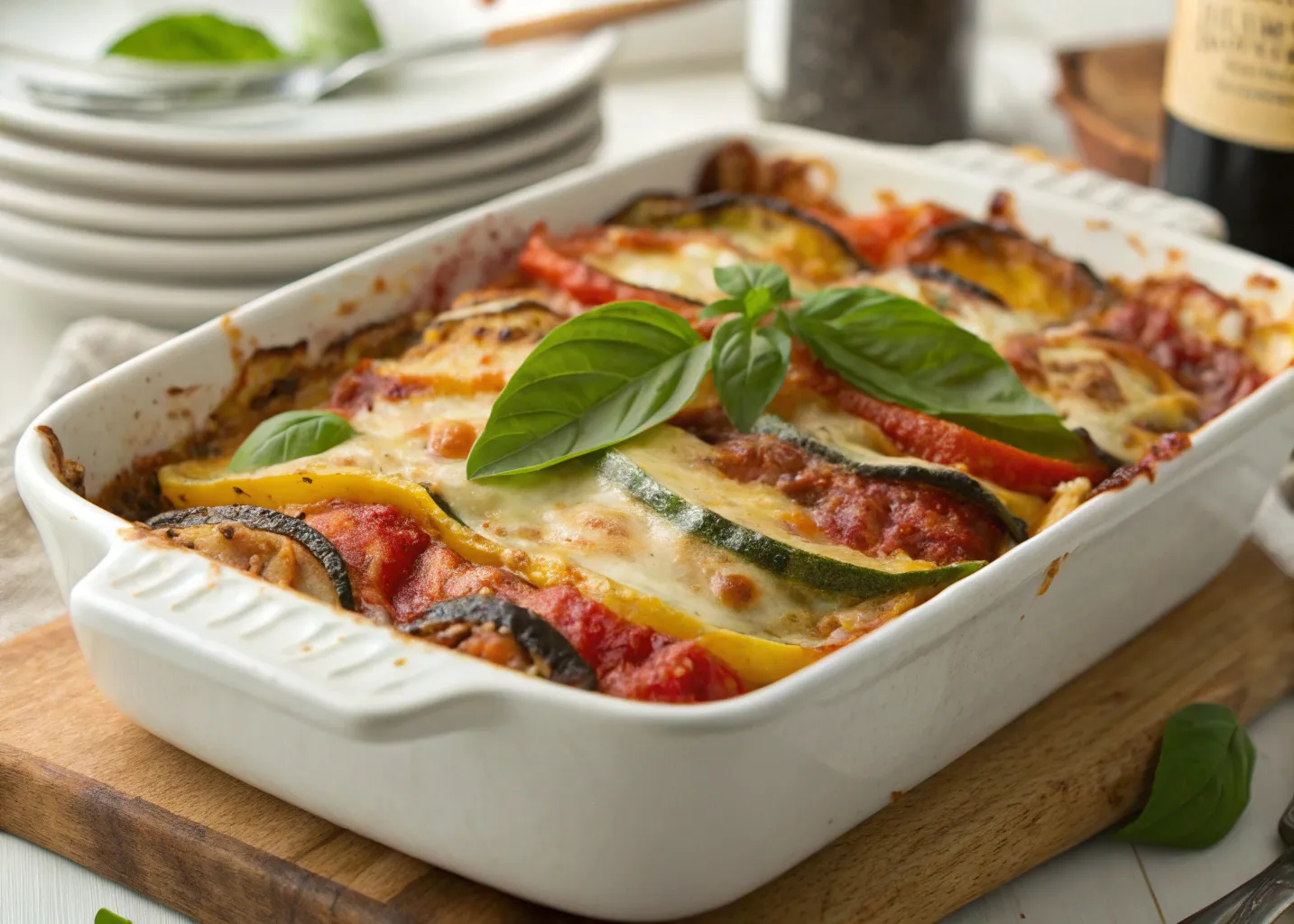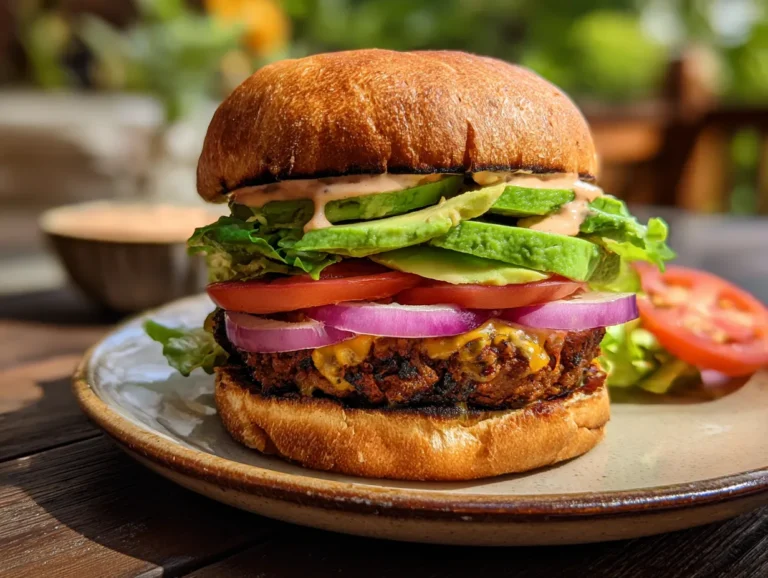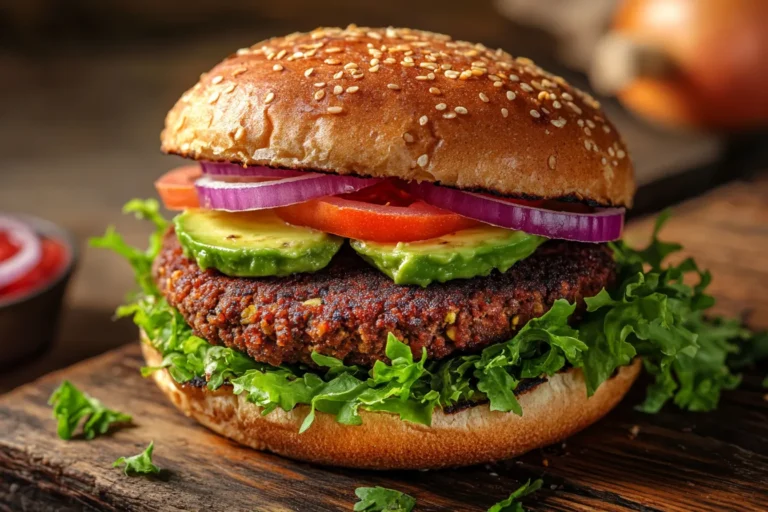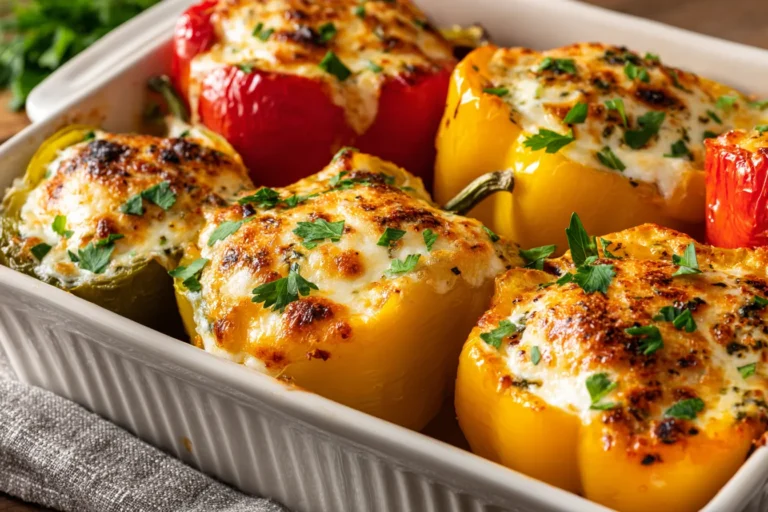If you’re craving comfort food that’s rich, hearty, and completely meat-free, this vegetarian lasagna recipe is exactly what you need. Made with layers of pasta, roasted vegetables, creamy ricotta, and bubbling cheese, it’s the perfect dish for cozy dinners, Sunday meal prep, or even dinner parties with friends.
Whether you’re vegetarian or just want to eat more plant-based meals, this lasagna delivers big on flavor without any meat. It’s filling, balanced, and flexible—plus, it’s a great way to use up seasonal veggies. And if you’ve ever wondered, What vegetables go best in lasagna? or How do you keep it from getting watery?, we’ve got you covered.
What Is Vegetarian Lasagna?
The Basics of a Vegetarian Lasagna
Vegetarian lasagna is a meatless twist on the traditional Italian lasagna. Instead of ground beef or sausage, it’s layered with fresh vegetables, tomato-based sauces, and multiple cheeses like ricotta, mozzarella, and Parmesan. You still get that rich, satisfying experience—but without any meat.
The core elements usually include:
- Cooked lasagna noodles (or oven-ready)
- A hearty vegetable filling
- Tomato or marinara sauce
- A creamy cheese layer
- Optional béchamel or pesto for extra depth
Whether you’re a full-time vegetarian or just looking for a meatless Monday dinner, this dish is perfect for anyone craving comfort without compromise.
Why Choose a Meatless Lasagna Recipe?
More people in the U.S. are cutting down on meat for health, sustainability, or ethical reasons. But skipping meat doesn’t mean sacrificing taste or nutrition. In fact, vegetarian lasagna is often packed with:
- Fiber from veggies
- Plant-based antioxidants
- Lower cholesterol (no red meat)
- Tons of flavor from herbs and slow-cooked sauces
Plus, it’s a family-friendly option that even picky eaters will enjoy. Once you’ve tried it, you might never go back to the meat version again.
Best Vegetables to Use in Vegetarian Lasagna
Top Vegetable Choices (Zucchini, Mushrooms, Spinach, etc.)
What veggies work best in lasagna? Ideally, you want a combination of hearty, moisture-balanced vegetables that can handle heat and bring layers of flavor. Here are the top choices:
| Vegetable | Flavor | Texture | Preparation |
|---|---|---|---|
| Zucchini | Mild & earthy | Soft when baked | Slice thin or roast first |
| Mushrooms | Savory & umami-rich | Meaty | Sauté to remove moisture |
| Spinach | Earthy & slightly sweet | Soft | Steam or sauté |
| Eggplant | Bold & smoky | Tender | Pre-cook to reduce bitterness |
| Bell Peppers | Sweet | Slight crunch | Roast or sauté |
| Carrots | Sweet & bright | Firm | Shred or finely chop |
These vegetables not only hold their own in the oven, but also enhance each bite with layers of flavor and texture.
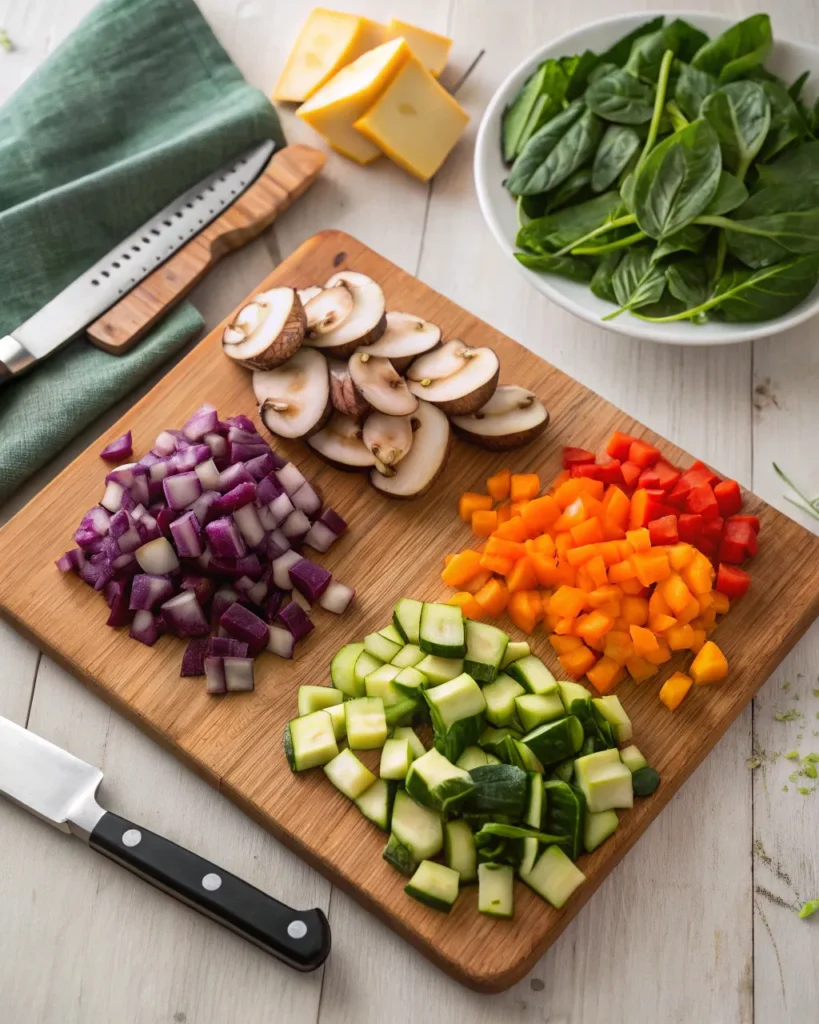
Seasonal Veggie Combinations for Extra Flavor
Want to keep things fresh and exciting? Rotate your lasagna based on what’s in season:
- Fall/Winter: Butternut squash, kale, sautéed leeks
- Spring: Asparagus, peas, artichokes
- Summer: Corn, zucchini, tomatoes
Combining fresh seasonal produce gives your lasagna a unique twist every time—and helps with affordability, too.
Tips for Balancing Texture and Moisture
Vegetables can release water as they bake, which may cause soggy lasagna. To avoid this:
- Cook your veggies first. Roasting or sautéing helps remove extra moisture.
- Salt watery vegetables like eggplant and zucchini, then pat them dry before using.
- Use a thick sauce. Thin sauces add more liquid, so go for something rich and hearty.
- Let it sit before slicing. After baking, give your lasagna 10–15 minutes to rest so the layers can set.
These small steps make a huge difference in the final texture. A well-structured vegetarian lasagna should be firm, not soupy.
Classic Italian Vegetarian Lasagna Ingredients
What Goes Into a Traditional Italian Vegetarian Lasagna
If you’re aiming for an authentic vegetarian lasagna with Italian roots, it’s all about balance. Italians have mastered the art of turning simple ingredients into rich, soulful dishes, and their approach to meatless lasagna is no different.
A classic version uses:
- Pasta sheets (fresh or dried lasagna noodles)
- Tomato-based sauce, often a slow-simmered marinara or homemade ragù sans meat
- Vegetables, roasted or sautéed to build deep flavor
- Cheese, in generous but balanced layers
It’s not just about piling on veggies—it’s about creating a layered experience of textures and taste that melt together as it bakes.
Essential Components: Pasta, Sauce, Vegetables, Cheese
Here’s a deeper look at the essentials that make every bite satisfying:
- Lasagna noodles: Choose between classic boiled pasta sheets or oven-ready ones. Whole-wheat or gluten-free options work well too.
- Sauce: Go for a chunky marinara or slow-cooked tomato sauce. Want a white twist? Try a béchamel or a creamy ricotta base in alternating layers.
- Vegetables: Use a hearty mix—zucchini, mushrooms, spinach, eggplant, bell peppers—roasted or sautéed to perfection.
- Cheese: Stick with Italian staples—ricotta for creaminess, mozzarella for stretch, and Parmesan for a salty finish.
It’s the combination of these components—not one element alone—that defines a well-built vegetarian lasagna.
Italian Cheeses That Work Best (Ricotta, Mozzarella, Parmesan)
Authenticity lies in using the right cheeses in the right amounts. In Italy, cheese isn’t just a topping—it’s an integral flavor and texture element.
- Ricotta: Smooth and creamy, it creates the lasagna’s soft, luscious middle. You can mix in chopped herbs or spinach for extra character.
- Mozzarella: Provides that irresistible melted cheese stretch. Use whole milk mozzarella for best results.
- Parmesan (or Grana Padano): Adds a salty, nutty top layer. Grate fresh for more flavor impact.
If you’re looking for dairy alternatives, you can use plant-based ricotta or vegan cheese shreds, but be sure to go for quality brands that melt well.
How to Prepare Eggplant for Lasagna
Should You Cook Eggplant First?
Yes — you should always cook eggplant before adding it to your vegetarian lasagna. Raw eggplant can be spongy, bitter, and full of water. Cooking it first helps remove that extra moisture, brings out a better flavor, and gives your lasagna a smoother, more delicious texture.
Whether you’re slicing it thin or using rounds, prepping it right makes a big difference in avoiding sogginess.
Best Methods: Roasting vs. Grilling vs. Sautéing
Eggplant is versatile, but not all cooking methods yield the same result in lasagna. Here’s how they compare:
| Method | Flavor | Texture | Pro Tip |
|---|---|---|---|
| Roasting | Mild, smoky | Soft but firm | Brush with olive oil and bake at 400°F for 20 min |
| Grilling | Smoky, deep | Slight char, meaty | Best for eggplant lovers |
| Sautéing | Rich, buttery | Soft & rich | Use minimal oil to avoid sogginess |
Roasting is the most popular method—it draws out water and intensifies flavor without adding excess oil.
How to Avoid Bitterness in Eggplant Layers
Bitterness in eggplant used to be a problem, especially with older varieties. But even today, salting eggplant slices before cooking helps remove any harsh notes and moisture.
Step-by-step tip:
- Slice the eggplant and lightly sprinkle salt on both sides.
- Let it sit for 20–30 minutes.
- Pat it dry with paper towels.
- Proceed to roast or sauté as planned.
This easy step gives the eggplant a soft, rich texture that adds to your vegetarian lasagna without taking over the flavor.
Step-by-Step Vegetarian Lasagna Recipe
Full Ingredient List (Easy to Source, Budget-Friendly)
This recipe fills one 9×13” baking dish and serves about 6 people. It uses simple, affordable ingredients—but tastes like something special.
Main Ingredients:
- 9 lasagna noodles (boiled or oven-ready)
- 1 large zucchini, thinly sliced
- 1 medium eggplant, roasted or grilled
- 1 cup mushrooms, sliced
- 3 cups baby spinach
- 2 cups marinara sauce (homemade or store-bought)
- 1½ cups ricotta cheese
- 2½ cups shredded mozzarella cheese
- ½ cup grated Parmesan cheese
- 2 tablespoons olive oil
- 1 teaspoon dried oregano
- ½ teaspoon garlic powder
- Salt & black pepper to taste
- Fresh basil for garnish (optional)
Pro tip: Use whole milk cheeses for the creamiest texture.
Instructions for Prepping the Veggies and Sauces
Let’s keep it simple and organized:
Step 1 – Prep the vegetables
- Zucchini: Slice into thin ribbons. Set aside.
- Eggplant: Slice, salt both sides, and let sit for 25 minutes. Rinse and pat dry. Roast at 400°F for 20 mins.
- Mushrooms: Sauté in olive oil over medium heat until browned (5–7 mins).
- Spinach: Sauté briefly in the same pan—just until wilted.
Step 2 – Prep the sauce
If you’re using homemade marinara, simmer it with garlic, onions, and oregano for deeper flavor. Store-bought works, too—just choose one without added sugar.
Step 3 – Ricotta mixture (optional)
For a flavor boost, stir a pinch of garlic powder and dried basil into your ricotta cheese.
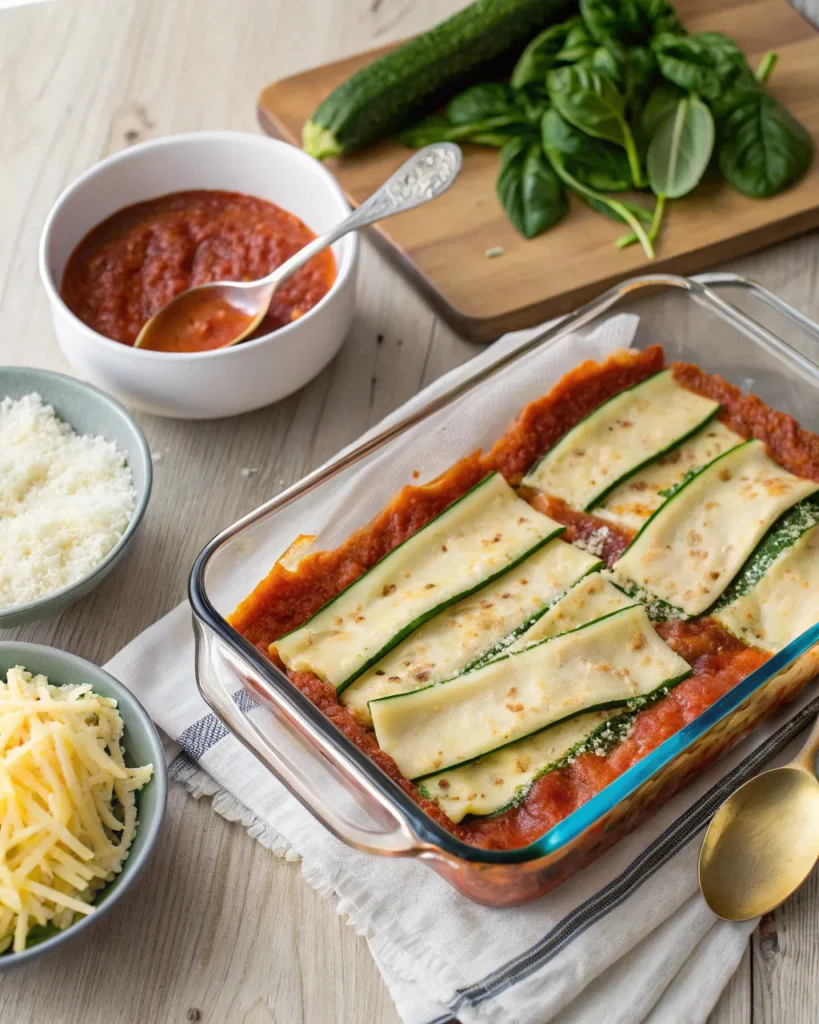
Assembling the Layers
Now comes the fun part. Preheat your oven to 375°F (190°C) and follow this order:
- Start by spreading a thin layer of marinara sauce on the bottom of the dish.
- Place 3 noodles across the sauce.
- Spread half of the ricotta mixture evenly over the noodles.
- Add sautéed spinach and mushrooms.
- Layer roasted eggplant and zucchini slices.
- Spoon on some sauce and sprinkle mozzarella.
- Repeat the layers in the same order: noodles, ricotta, vegetables, sauce, then cheese.
- Top with remaining sauce, mozzarella, and Parmesan.
Baking Time, Temperature & Final Touches
- Cover the dish loosely with foil and bake for 30 minutes.
- Take off the foil and bake for another 10 to 15 minutes, until the top is bubbly and golden.
- Let rest for 10–15 minutes before slicing to avoid a runny center.
Optional: Garnish with fresh basil and an extra sprinkle of Parmesan for a pop of color and flavor.
What to Serve with Vegetarian Lasagna
Best Italian Side Dishes (Bread, Salad, Roasted Veggies)
Want to build a full Italian dinner around your vegetarian lasagna? Keep the sides light, fresh, and complementary.
Here are perfect pairings:
- Garlic bread or focaccia – Crispy outside, soft inside, and great for soaking up extra sauce.
- Arugula salad with lemon vinaigrette – The peppery greens balance the richness of the lasagna.
- Roasted vegetables – Carrots, Brussels sprouts, and cherry tomatoes add texture and color.
- Caprese salad – Made with fresh mozzarella, tomatoes, and basil, topped with a drizzle of balsamic.
These additions elevate your lasagna night without stealing the spotlight.
Looking for a fresh side? Try our Caesar Pasta Salad — it pairs perfectly with cheesy vegetarian lasagna.
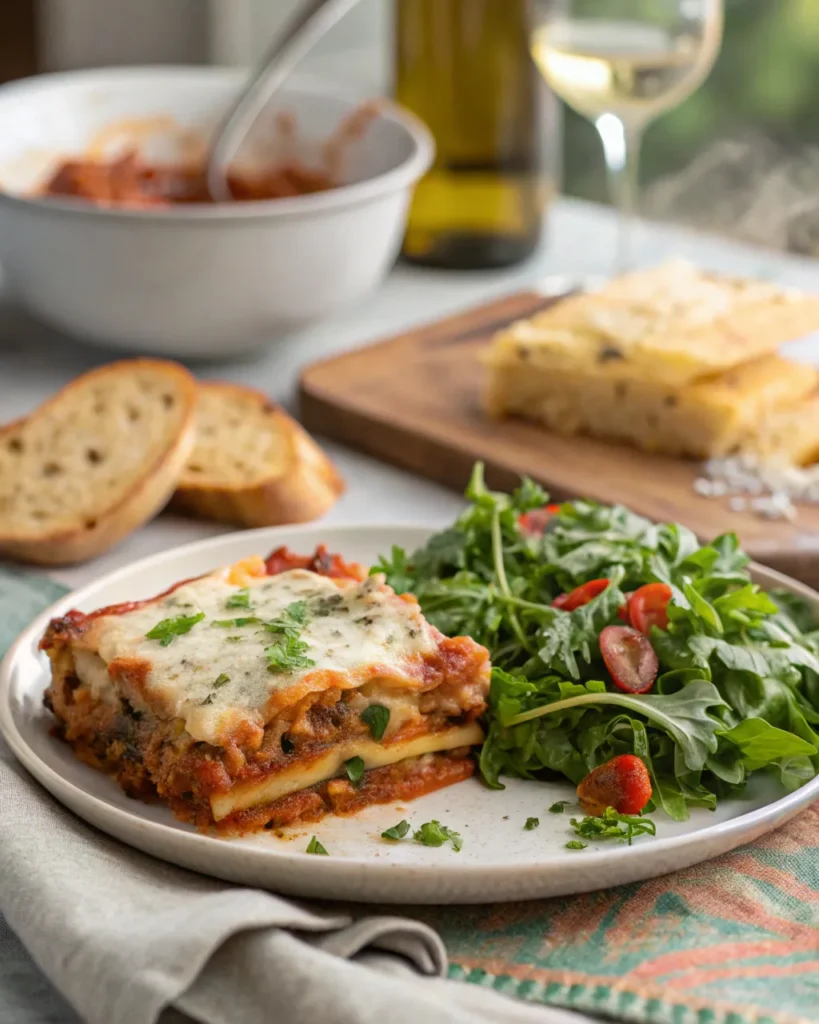
Italian Beverage Pairings for Lasagna Night
Pair your meatless Italian dinner with something that complements the flavors:
| Beverage | Notes |
|---|---|
| Red wine (Chianti, Pinot Noir) | Classic with tomato-based dishes |
| Sparkling water with citrus | Keeps the palate fresh |
| Iced herbal tea (lemon or mint) | Refreshing for summer meals |
| Non-alcoholic sangria | Fruity and fun for family dinners |
Whatever you choose, go for balance—nothing too overpowering.
How to Plate and Present the Meal Beautifully
Presentation matters, especially when serving guests or sharing photos online.
Pro tips:
- Use a sharp knife to cut the lasagna into neat squares.
- Serve each slice on a white or neutral-colored plate to make the colors pop.
- Garnish with a sprig of fresh basil and a drizzle of olive oil.
- Add a small side salad or a lemon wedge for contrast.
It’s a simple dish, but plated right, it looks like something from a rustic Italian trattoria.
Avoiding a Watery Vegetarian Lasagna
Common Causes of Watery Lasagna
A watery vegetarian lasagna can ruin the texture and presentation, turning a beautiful dish into a soggy mess. This is a common issue, especially when working with moisture-rich vegetables.
The most frequent culprits include:
- Uncooked or undercooked vegetables
- Too much sauce or thin marinara
- Skipping the resting time after baking
- Using uncooked eggplant or zucchini without salting
Because vegetables naturally contain water, failing to remove or control that moisture leads to watery layers that won’t set properly.
Tips to Avoid Excess Moisture (Veggie Prep & Sauce Thickness)
Want lasagna that holds together in perfect slices? Follow these foolproof tips:
- Roast or sauté your vegetables before layering
This evaporates much of their internal water, especially for spinach, zucchini, and mushrooms. - Salt and drain eggplant and zucchini
Sprinkle with salt and rest for 20–30 minutes, then blot with paper towels. This draws out excess liquid and bitterness. - Use a thick sauce
Avoid watery, jarred sauces with added sugar. If necessary, simmer marinara for 10–15 minutes to reduce and thicken. - Drain spinach well
If using frozen spinach, squeeze out every drop of water after thawing. If fresh, sauté briefly and drain. - Don’t overdo cheese sauces
Creamy components like béchamel or ricotta add richness, but too much can lead to excess moisture when baked. - Bake uncovered at the end
During the last 10–15 minutes, remove the foil to let moisture escape and create that beautiful golden top layer.
How to Let Lasagna Set Properly Before Serving
Even after the perfect bake, your lasagna needs time to rest and set. Cutting too soon is a common mistake.
Here’s what to do:
- After baking, remove the lasagna from the oven.
- Let it sit for 10–15 minutes at room temperature.
- This allows the layers to firm up and hold their shape when sliced.
Not only does this improve presentation, but it enhances flavor—just like how soup tastes better after resting.
Make-Ahead, Freezing, and Storage Tips
Can You Freeze Vegetarian Lasagna?
Absolutely! Vegetarian lasagna freezes beautifully, making it a great make-ahead meal for busy weeknights or family gatherings.
You can:
- Freeze before baking – assemble everything, wrap tightly in foil and plastic, and freeze for up to 3 months.
- Freeze after baking – let it cool completely, cut into portions if desired, and wrap or containerize individually.
Always label with the date and baking instructions. Reheat within 2–3 months for best taste and texture.
Tip: If freezing unbaked lasagna, use a foil pan to go directly from freezer to oven.
Reheating Without Drying It Out
When reheating vegetarian lasagna, maintaining moisture is key—but you don’t want it soggy either.
Here’s how:
- If frozen, bake the whole dish at 375°F with foil on for 60 to 75 minutes. Take off the foil for the last 10 minutes.
- From fridge (leftovers): Bake covered at 350°F for 20–25 minutes. Or microwave slices with a damp paper towel on top for 2–3 minutes.
- Add extra sauce if needed before reheating to prevent dryness.
Use a thermometer if needed: the center should reach at least 165°F.
How Long Does It Keep in the Fridge?
Once baked and cooled:
- Keep it in a sealed container or wrap the dish tightly.
- Keep in the refrigerator for up to 4 days.
- Always reheat only what you’ll eat—don’t reheat, cool, and reheat the same slice multiple times.
For meal preppers, this lasagna is ideal. You can even build two pans at once—one to eat tonight, one to freeze for later.
Frequently Asked Questions About Vegetarian Lasagna
What goes into vegetarian lasagne?
A classic vegetarian lasagna includes layers of lasagna noodles, sautéed or roasted vegetables, tomato-based marinara or pasta sauce, creamy ricotta or béchamel, shredded mozzarella, and grated Parmesan. The vegetable mix often features zucchini, mushrooms, spinach, and eggplant. Some recipes may also use lentils or plant-based meat alternatives, but the traditional version relies on real vegetables for heartiness and depth of flavor.
What veg is best in lasagna?
The best vegetables for lasagna are those that hold up well during baking and add texture, flavor, and nutrition. Top choices include zucchini, mushrooms, spinach, eggplant, and bell peppers. These vegetables blend well with cheese and sauce, and when roasted or sautéed, they avoid making the dish watery. For seasonal variations, add kale, leeks, butternut squash, or artichokes.
Do Italians make vegetarian lasagna?
Yes, they do. While traditional lasagna in Italy often includes meat ragù, many regional variations are completely meat-free. For example, in northern Italy, it’s common to see lasagne made with spinach, ricotta, and béchamel. Vegetarian lasagna is especially popular during Lent or among families who follow a Mediterranean-style diet rich in vegetables and olive oil.
Do I need to cook eggplant before putting in lasagna vegetarian?
Yes, you should pre-cook eggplant before layering it into lasagna. Raw eggplant releases a lot of water and can turn bitter or rubbery if baked from raw. The best methods are roasting or sautéing the slices after salting and draining them. This enhances flavor, improves texture, and helps prevent your lasagna from becoming watery.
What do Italians serve with lasagne vegetarian?
Italians typically serve simple, fresh sides with lasagna to balance the richness of the main dish. Common pairings include:
- Arugula or mixed green salads
- Crusty bread or focaccia
- Roasted seasonal vegetables
- Light red wines like Chianti or a sparkling mineral water
These sides enhance the meal without overwhelming the lasagna’s layered flavors.
Why is my vegetarian lasagna watery?
The most common reason your vegetarian lasagna turns out watery is because the vegetables released too much moisture during baking. This happens when you skip pre-cooking your veggies, use thin sauces, or cut into the lasagna too soon. Solutions include roasting or sautéing vegetables first, simmering sauces to reduce them, and letting the dish rest after baking so the layers can firm up.
CONCLUSION: Why Vegetarian Lasagna Is the Ultimate Meatless Comfort Food
If you’re looking for a comforting, satisfying dish that skips the meat but delivers all the flavor, vegetarian lasagna is your go-to recipe. It’s hearty enough for a dinner party, yet simple enough for weeknight meals. By layering perfectly cooked vegetables, rich sauces, and gooey cheeses, this lasagna satisfies vegetarians and meat-lovers alike.
Whether you prep it ahead, freeze it for later, or serve it hot from the oven, this meatless marvel will become a regular in your dinner rotation. Give it your own twist with seasonal veggies or try different cheeses to make it your own.
Craving something warm and comforting next? Try our stuffed shells with ricotta and spinach — it’s a perfect meatless dish loaded with creamy flavor and ideal for cozy nights in.
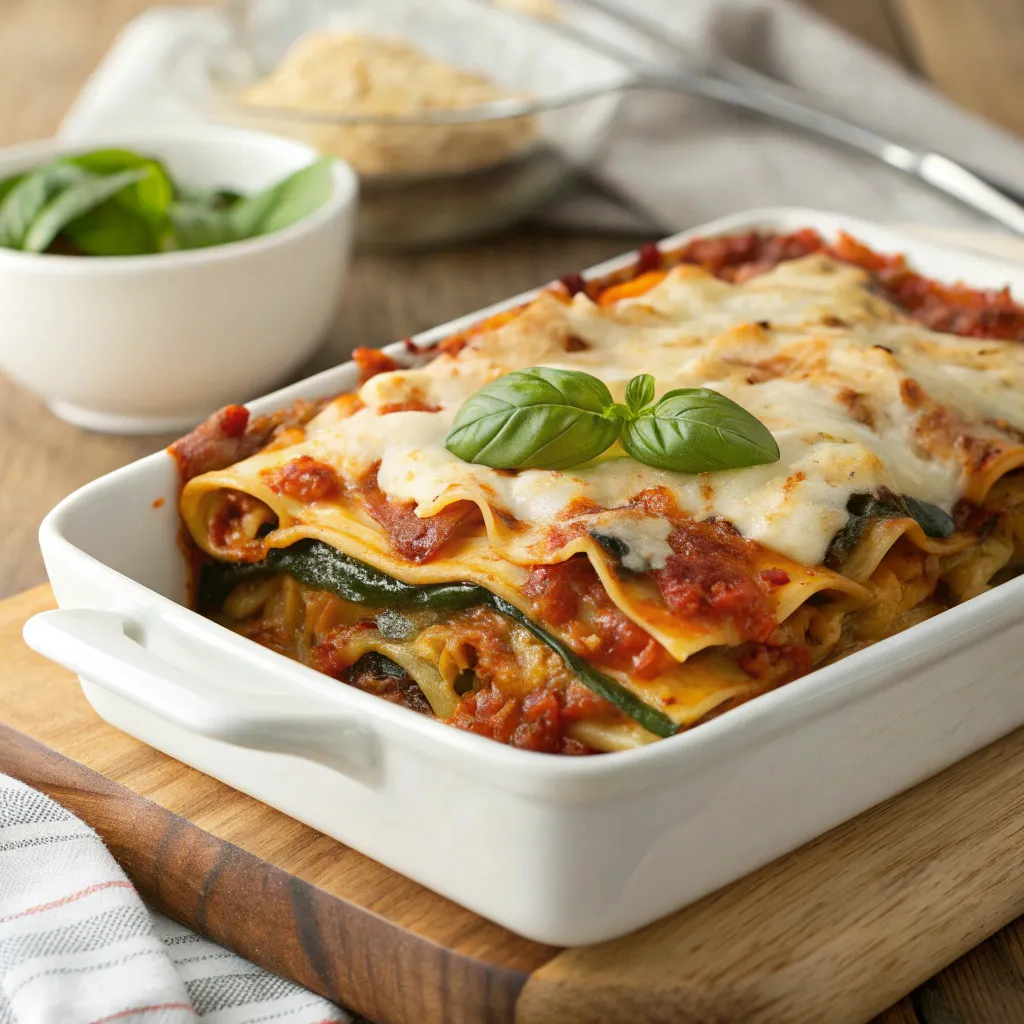
Vegetarian Lasagna
Ingredients
Equipment
Method
- Slice zucchini and set aside.
- Salt eggplant on both sides and let sit 25 mins. Rinse, pat dry, and roast at 400°F for 20 mins.
- Sauté mushrooms until browned. Add spinach and cook until wilted.
- Stir garlic powder and oregano into ricotta for extra flavor.
- Preheat oven to 375°F.
- Spread marinara sauce on the bottom of a 9×13” dish.
- Add 3 noodles, half the ricotta, spinach, mushrooms, eggplant, zucchini, sauce, and cheese.
- Repeat layers. Top with sauce, mozzarella, and Parmesan.
- Cover loosely with foil. Bake for 30 minutes.
- Remove foil and bake 10–15 more minutes until bubbly and golden.
- Let rest for 10–15 minutes before slicing. Garnish with basil.
Notes
- You can freeze this lasagna before or after baking.
- For a gluten-free version, use gluten-free noodles.
- Add red pepper flakes to the ricotta for a spicy twist.


